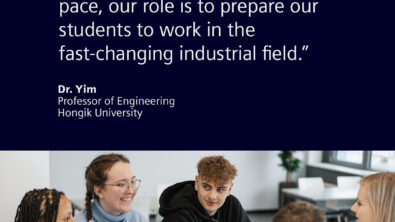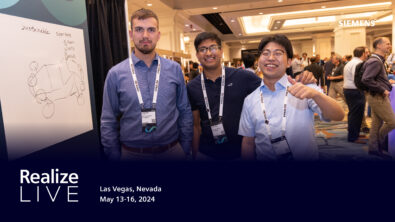Siemens Helps Prepare Students for the Workforce by Partnering With Formula SAE®

Siemens Digital Industries Software’s academic program has an extensive history of supporting Formula SAE teams with software, training, and collaborations, so we were honored to be a sponsor the Formula SAE events in Michigan and Lincoln again this year as it gave us a chance to talk with students, demonstrate how the software can be used to help them, and more.
Here we’ll discuss:
-
-
- Overview of the Formula SAE events and industry commitment (skip to this)
-
-
-
- Skillshop sessions at FSAE Michigan (skip to this)
-
-
-
- Students turn to Siemens software and training (skip to this)
-
 Siemens logos displayed at FSAE Michigan and Lincoln 2019, showing just some of the teams we support.
Siemens logos displayed at FSAE Michigan and Lincoln 2019, showing just some of the teams we support.
Event overview and industry commitment
The Formula SAE® competitions challenge University undergraduate and graduate students from nearly 200 domestic and international teams to conceive, design, fabricate, develop, test, and compete with small, formula-style racecars. Teams compete in static events such as design, business, and cost to judges from the auto industry, and compete in dynamic events such as acceleration, skidpad, autocross, endurance, and efficiency.Using best-in-class software helps with both aspects of the competition.
1) Formula SAE® Michigan: For combustion engine racecars, attended by 119 University teams at the Michigan International Speedway in May, 2019.
 The Michigan event’s 1st place overall was won by the U. of Stuttgart team, seen here in their pits getting ready for the next event – supported by Siemens Software, their downforce aero package was optimized with STAR-CCM+ software.
The Michigan event’s 1st place overall was won by the U. of Stuttgart team, seen here in their pits getting ready for the next event – supported by Siemens Software, their downforce aero package was optimized with STAR-CCM+ software.
 TU Graz racecar – 2nd Place overall SAE Michigan. Also featuring a super light carbon-fiber composite chassis, and a potent carbon aero-downforce package for rapid cornering, also optimized with Siemens’ STAR-CCM+® 3D-CFD software.
TU Graz racecar – 2nd Place overall SAE Michigan. Also featuring a super light carbon-fiber composite chassis, and a potent carbon aero-downforce package for rapid cornering, also optimized with Siemens’ STAR-CCM+® 3D-CFD software.
The remaining 3 places of the top-5 finishers also had access to Siemens software, as well as many of the top-20 finishers.
2) Formula SAE® Lincoln for both Electric and Combustion powered racecars attended by 80 University teams near Lincoln, Nebraska in June 2019.
The Lincoln, Nebraska event in June featured both Formula Electric and Formula Combustion competitions.Formula SAE® Electric allows the development of fully electric vehicles within the FSAE® framework. In 2020, this event will move to California.
In addition to the FSAE events in Michigan and Lincoln, Siemens supports and attends Formula Student events in Austria, Germany, China and Japan. For more images from Michigan and Lincoln, see the appendix below (skip to this).
Industry commitment
These students are highly sought after by industry (see logos below) because they have been prepared for the workforce as they not only design and build a new race car from the ground up each year, but they must work as a team to do this while handling other elements such as business and cost management, marketing, recruiting and training new members, and logistics.These students have proven to be passionate, hard-working, smart and high-initiative engineers (many schools don’t even give academic credit for their Formula car projects.)Engineering theory classes are difficult enough to handle, but these students often put in 80-hour weeks or more to compete at the highest levels in Formula SAE.Siemens offers no-cost software grants and training resources to help address the worldwide engineering workforce gap due to aging demographics in most of the developed countries.
 Many FSAE event sponsors are among Siemens customers. We are pleased to aid in preparing students for their careers through our support of FSAE!
Many FSAE event sponsors are among Siemens customers. We are pleased to aid in preparing students for their careers through our support of FSAE!
 Ford’s booth for recruiting Formula SAE students, featuring their rapid 2019 GT 350 Mustang and the ultra-sophisticated Le Mans class GT racecar, which students loved to see in person.
Ford’s booth for recruiting Formula SAE students, featuring their rapid 2019 GT 350 Mustang and the ultra-sophisticated Le Mans class GT racecar, which students loved to see in person.
 Hendricks Motorsports, a top NASCAR racecar builder also actively recruits Formula SAE students, especially with Siemens Software experience – ready to hit the ground running at Hendricks.
Hendricks Motorsports, a top NASCAR racecar builder also actively recruits Formula SAE students, especially with Siemens Software experience – ready to hit the ground running at Hendricks.
Siemens Software Skillshops for Formula SAE Students
During the 2 Siemens Software shillshops at the Michigan competition, we highlighted how Siemens software is best used by teams to design and optimize their racecar designs. Gary Gorman demonstrated on a laptop how users can easily open and interact with a 14,000+ part NASCAR model in NX (a model that a common CAD competitor package can’t even open). Gary also demonstrated how to easily import and add intelligence to a Parasolid part from another CAD tool (without a history tree) using NX’s synchronous technology. Dave Strauss demonstrated how Fibersim can be used to simulate composite fiber designs in order to make lighter, stronger parts andprevent fabrication flaws and save time through the development of flat pattern cutouts. Then Sumash Nakka (Univ. of Cincinnati) demonstratedlap-time and suspension simulations in Amesim.
 Gary Gorman (left) displaying a complete, very complex NASCAR model in NX along with Dave Strauss (right) demonstrating Fibersim.
Gary Gorman (left) displaying a complete, very complex NASCAR model in NX along with Dave Strauss (right) demonstrating Fibersim.
Chris Penny from Siemens’ U.S. academic team demonstrated and presented how STAR-CCM+ can be leveraged for external aerodynamics, tank sloshing, restrictor design, intake manifolds, and more. Leigh Anderson from the global academic team covered the software grant process and an overview of the other ~15 software packages relevant to these teams.About 35 teams and 90 students in all attended the 2 workshops at Michigan.
 Chris Penny explaining how STAR-CCM+ can be used in FSAE. The screen shows the turbulent air (Q-Criterion) around the Univ. of Manitoba’s FSAE car.
Chris Penny explaining how STAR-CCM+ can be used in FSAE. The screen shows the turbulent air (Q-Criterion) around the Univ. of Manitoba’s FSAE car.
 Both 2-hour Siemens Software workshops were well-attended at Formula SAE Michigan. Here Leigh is explaining how to get no-cost software grants and online training.
Both 2-hour Siemens Software workshops were well-attended at Formula SAE Michigan. Here Leigh is explaining how to get no-cost software grants and online training.
Students turn to Siemens
We back 87 teams in the USA, Canada, Germany, Austria, and Poland that attended the U.S. events (see list below) and ~300 Formula Student teams worldwide. This includes all top 5 teams from both the Michigan and Lincoln events (by overall score). Teams are turning to Siemens because they realize that we can help them overcome issues with hard-to-learn, limiting, or incapable engineering software and they can use our FSAE-specific tutorials, and online software tools training resources to reduce their software learning curve, make better design decisions, and focus their time on developing a better car. We also partner with them to keep the developed content relevant to them.


For example, we collaborated with FSAE teams at Univ. of Akron, Lawrence Tech, Cal Poly SLO, and Villanova to develop a STAR-CCM+ simulation template so that students can build a complete CFD simulation in 1 hour. Users simply tag their parts and the sim looks for these tags to feed into a surface wrapper, the meshing operations, models, boundary conditions, reports, plots, and scenes. This is made possible by the way STAR-CCM+ interconnects each step of the simulation process and through robust, high quality meshing.
Another collaboration with the California Polytechnic San Louis Obispo FSAE team led to the development of an article that shows how to setup a radiator duct and fan sim in STAR-CCM+. This includes an experimental validation and design exploration studies.
 FSAE-specific content resulting from our collaboration with FSAE teams.
FSAE-specific content resulting from our collaboration with FSAE teams.
We see that more and more FSAE teams find that their existing CAD software cannot handle large assemblies – and it doesn’t include composite-fiber draping simulations, CAM, accurate FEA, wire-harness design tools or e-learning – all of which we provide through an integration of NX, Fibersim, and VeSys. VeSys software even integrates with their chassis designs in NX to calculate 3D wire-lengths so the wire-harness can be ready as soon as the chassis is fabricated.
 Global Formula Racing report on how Fibersim helped them develop their composite parts while saving time and material cost.
Global Formula Racing report on how Fibersim helped them develop their composite parts while saving time and material cost.
 T.U. Munich team’s sophisticated Formula Electric AWD-Drivetrain & wiring harness, designed with VeSys and NX.
T.U. Munich team’s sophisticated Formula Electric AWD-Drivetrain & wiring harness, designed with VeSys and NX.
For printed circuit board (PCB) design, software like PADS Professional replaces common buggy ‘freeware’ PCB software. This professional level PCB tool is especially critical for Formula Electric teams who have to design custom high-voltage, high-current boards packed into a compact space in their racecars. Electrical integrity can be checked with the companion PCB verification tool called Hyperlynx, to prevent electrical glitches during the Endurance event for example.
More and more teams ask for these Siemens software tools along with product data management, mechatronics, and our other software.
We also provide supported teams with no-cost on-demand/online training and FSAE-specific design tutorials. Siemens’ Formula Student and FSAE forum has many valuable tips for designing, simulation, guidance for accessing e-learning, and much more.
Leigh Anderson, Chris Penny and the other Siemens workshop instructors look forward to seeing the SAE teams in 2020!
 Chris Penny with Arizona State’s Formula SAE team at the SAE Lincoln event.
Chris Penny with Arizona State’s Formula SAE team at the SAE Lincoln event.
Appendix
 Here is the waiting line for entry into the technical inspection garage where auto industry experts examine the cars and mentor the students on safe engineering and fabrication techniques.
Here is the waiting line for entry into the technical inspection garage where auto industry experts examine the cars and mentor the students on safe engineering and fabrication techniques.
 Female engineers are increasingly well-represented as hand-on members of Formula SAE teams in N. America, and worldwide.
Female engineers are increasingly well-represented as hand-on members of Formula SAE teams in N. America, and worldwide.
 A section of the Endurance race course, which features many tight turns – the motivation for using STAR-CCM+ for aero downforce optimization and thus maximizing grip and cornering power.
A section of the Endurance race course, which features many tight turns – the motivation for using STAR-CCM+ for aero downforce optimization and thus maximizing grip and cornering power.
 The Oregon State U./DHBW Ravensburg Global Formula Racing team’s car at the Michigan event, which finished in 5th place overall. The GFR team is one of the most sophisticated users of Siemens’ software in all of Formula Student worldwide. Coincidentally, GFR has won 1st place in the worldwide Formula Student ranking of ~550 teams an amazing 4 times!
The Oregon State U./DHBW Ravensburg Global Formula Racing team’s car at the Michigan event, which finished in 5th place overall. The GFR team is one of the most sophisticated users of Siemens’ software in all of Formula Student worldwide. Coincidentally, GFR has won 1st place in the worldwide Formula Student ranking of ~550 teams an amazing 4 times!


